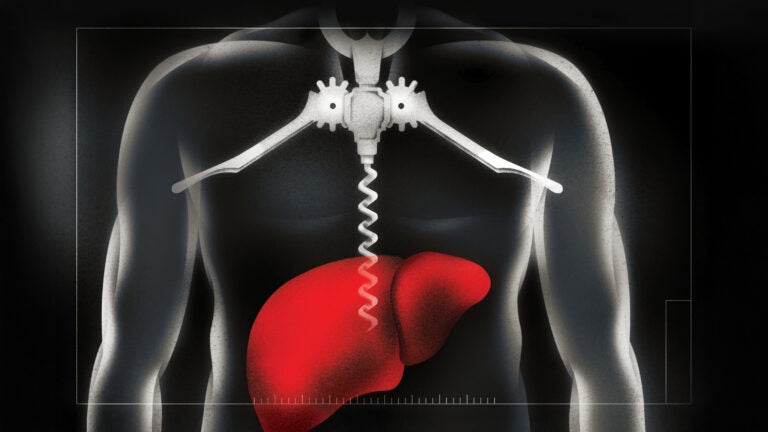
USC doctors are working to mitigate a post-COVID rise in alcohol-related liver disease. (Illustration/Brian Stauffer)
USC doctors are leading treatment of the post-COVID rise in alcohol-related liver disease
Alcohol-related liver disease has quietly surged to become the leading cause of alcohol-related deaths. USC is leading the charge to change that.
In the wake of the COVID-19 pandemic, another crisis has been unfolding — one that isn’t making headlines but is claiming thousands of lives. Alcohol-related liver disease has quietly surged to become the leading cause of alcohol-related deaths, surpassing even motor vehicle fatalities. At Keck Medicine of USC, doctors like hepatologist Brian P. Lee see the consequences firsthand.
“The liver is the great filter of the body. It detoxifies the blood, drugs and bile that go through it,” says Lee, a liver transplant specialist and an associate professor of clinical medicine at the Keck School of Medicine of USC. “Other organs are dependent on your liver, and if your liver fails, then often, your kidneys and other organs will also fail.
“Every day at my clinic, I see several patients who have had their livers destroyed as a consequence of alcohol use. Our hospital unit is full of patients with liver disease and liver failure in need of a transplant.”
During the COVID-19 pandemic in 2020, Lee and his colleagues saw a pronounced increase in patients with liver disease. “Hospital admissions to Keck were up more than 30% due to alcohol-related conditions, and liver disease was among the most common conditions,” he says. That year also reflected an increase in alcohol sales — up 34% from 2019 to 2020. The hospitalization surge led Lee and his colleagues to investigate why in a study.
“At the time, we thought that people were drinking more during lockdown because they were more stressed, and once things got back to ‘normal,’ drinking rates would decrease,” Lee says. “That’s not what we’ve been seeing in the hospital.”
A LINGERING PANDEMIC LEGACY
In 2024, Lee was the principal investigator for a Keck Medicine follow-up study specifically examining the rate of alcohol consumption. He and fellow researchers found that the increases they saw in 2020 were sustained, if not higher, in 2022. They studied data from the National Health Interview Survey, one of the largest and most comprehensive health surveys in the country, which collected alcohol use information as well as demographic and socioeconomic data for more than 24,000 adults 18 years and older. While the U.S. Department of Health and Human Services announced the official end of the pandemic in May 2023, the National Health Interview Survey defined the year 2022 as post-pandemic, as regular lifestyle routines were beginning to resume.
The researchers compared 2018 with 2020 alcohol use numbers, then compared 2018 with 2022.
They found that from the pre-pandemic year of 2018 to the height of the pandemic in 2020, heavy alcohol use among Americans rose by 20%, and alcohol use of any amount rose by 4%. In 2022, increases were sustained, and the rise in drinking was seen across all age groups, genders, race, ethnicities and regions of the country, except for Native Americans and Asian Americans. Adults ages 40 to 49 had the highest increase in alcohol use.
The Keck Medicine study did not analyze why alcohol consumption increased between 2018 and 2022, but Lee says there are general hypotheses. “We know that people use alcohol as a coping mechanism,” he says. He points to Hurricane Katrina’s widespread devastation in 2005 and the events of 9/11 in 2001 when rates of alcohol and smoking increased.
“But those were temporary bumps,” Lee notes. “The thought is the pandemic was more sustained, and when you have a trigger for increasing alcohol use, we know even if you remove the trigger, it doesn’t necessarily remove the substance use disorder. Meaning the habit can become more than just a habit and become a way of life — an addiction.”
THE PATH TO LIVER FAILURE
Last December, a 63-year-old patient at Keck Medicine of USC received a liver transplant. He had fatty liver, and alcohol-related liver disease — and had developed cancer within the liver, says his surgeon, Navpreet Kaur. He was discharged within five days. About two months later, he was ready to go back to golfing and work.
“For patients like him, recovery can be very quick, and they can resume doing the things they enjoyed before they got sick,” she says.
While relatively common, liver transplantation is a “demanding and technical operation,” according to Kaur, an assistant professor of clinical surgery at Keck School of Medicine who performs more than 40 liver transplants annually. Each transplant candidate under-goes a rigorous pre- and post-surgery evaluation for physical health, mental health and assessment of their out-of-the-hospital support system. But, the illness of alcohol addiction can be a challenging foe, and post-transplant success depends on a change in health habits, including alcohol consumption.
“Years ago, I had a patient with acute alcohol-related liver disease. She did very well with the surgery,” Kaur says. Unfortunately, a year later, the patient began to drink again. After the patient’s primary care provider helped her get sober through psychiatry and therapy, Kaur says, “she was able to persevere and become sober, without any effect to the liver transplant itself.”
Because alcohol use is the most common cause of liver disease, it accounts for more than 50% of liver-related deaths. The second most common cause is fatty liver, which is related to obesity.
There are four stages of liver disease, and each stage monitors the scarring of the liver — known as cirrhosis. The scarring results when the liver repairs itself and regenerates after damage from alcohol or other causes. In the fourth stage, the liver is usually too scarred to repair itself.
“The liver can regenerate, but only up to a point,” Lee says. “Even if you have small amounts of healthy liver, you may feel fine, but when it’s really damaged, people may develop fluid in the belly, leg swelling, confusion, bleeding from large vessels or jaundice. Liver failure can develop very quickly.” After that, a transplant is likely the only option.
THE UNSEEN TOLL ON YOUNGER ADULTS
Why are people younger than 50 years old at special risk for alcohol-related liver disease? During the time of the study, alcohol use increased in all ages and nearly all demographics. “But young adults, especially younger women, have been the fastest contributor to increasing liver-related deaths, and no one is quite sure why,” Lee says. In this instance, the hypotheses have to do with the circumstances endured during the COVID-19 pandemic.
There were well-known stressors during the pandemic for this age group. “For example, some were supposed to be in the golden years of their careers, and suddenly that’s upended by the pandemic,” Lee says. “Many women had young children or teenagers in the household who had to move to remote learning.”
In the research study, adults were characterized as having any alcohol use or heavy alcohol use within one year of the survey, and researchers calculated the rate of both measures of alcohol use. Heavy drinking for men was defined as greater than or equal to five drinks on any given day or 15 drinks a week. For women, it was greater than or equal to four drinks on any given day or eight drinks a week.
Time and time again even people with liver failure are shocked to know that their drinking habit led to the failure.
— Brian P. Lee
SHIFTING THE FOCUS TO PREVENTION
Working on the frontlines of health care, Lee sees the reaction and surprise among his patients. “Time and time again, even people with liver failure are shocked to know that their drinking habit led to the failure,” he says. “For me, it’s about finding treatments for our patients, of course, but it’s also about preventing people from being in that situation to begin with.”
Because so many of their patients at Keck Medicine are middle-aged, Kaur says prevention information must reach people earlier in life. “When someone starts drinking at age 21, nobody talks about what alcohol does to your body,” she says. “We talk about he risks with smoking, but alcohol is a very acceptable recreational substance in this country. We need to educate young people about the long-term effects of alcohol.”
Other studies show that people who drink are underreporting it, but health professionals know that more than 70% of Americans drink. “So, more than likely, a patient is drinking, and it’s very important for a doctor to know how much they drink so that they may conduct the appropriate tests,” Lee says. “The more I see transplants, the more I realize the importance of how much we can do in terms of prevention. Liver disease due to alcohol consumption is preventable.”
Lee hopes the Keck Medicine research study will inform both doctors and patients. “If you are drinking above the threshold, it’s really important to talk to your doctor about that so you can be screened for health problems,” he says. “If caught early, you might be able to prevent and treat the progression of liver disease.”
Both Kaur and Lee understand that the word ‘alcoholic’ is considered stigmatizing language. “There’s a stereotype that someone must be drinking two cases of liquor a day,” Lee says. “But that’s not what we are seeing in the clinic.”
Generally, Kaur adds, society is OK with “recreational substances, like alcohol, in a social setting. But, when someone is overconsuming alcohol, we draw away from them instead of asking them if they have stresses in their life that they need help with.
“In turn, the person drinking loses more of their support system, and they may consume more. So, it’s not only a physician or a health care worker who needs to help them; I think we have to look at it from a societal point of view and help each other.”
A GROWING NEED FOR ORGAN TRANSPLANTS
Concurrent with the post-pandemic increase in alcohol consumption is the increased demand for available livers for transplantation, which is the definitive treatment for end-stage liver disease. Keck Medicine performs about 150 liver transplants a year.
However, there is a shortage of donor livers. “We have an organ and supply mismatch, and at any given time, about 15,000 people are on the liver transplant wait list nationally,” Lee says. “About 20% to 30% of patients who need a liver will not receive a transplant. We need to continue to get the word out to the public because we need every organ.”
Public education about organ donation and new technologies to improve the viability of donated livers for transplant are on the rise.
A SECOND CHANCE AT LIFE
Over the years, Lee has seen the reasons his patients’ lifestyles have caused damage to their livers. “I’ve had people who drink more because their parents passed away, for example, or they lost their job,” he says, adding that most are surprised by the severity of their illness. “They did not know they had liver disease because they didn’t have symptoms before, and then they develop liver failure and undergo a transplant surgery.”
The evaluation process for transplants is extremely rigorous. “We have a whole team that works with patients, including liver doctors and surgeons, social workers, psychiatrists, addiction specialists, physical therapists and nutritionists,” Lee says. “The psychosocial evaluation ensures each patient is both physically and mentally strong enough to go through the transplant process and be a steward of the transplanted organ for years and decades to come.”
He calls it the “miracle of transplant.”
“One week after the transplant, they are walking out of the hospital,” Lee says. “Most people who undergo transplant due to alcohol stop drinking completely, and they really change their lives around because they are so appreciative. And that’s the ethos of transplant. It’s the idea of a second chance.”



